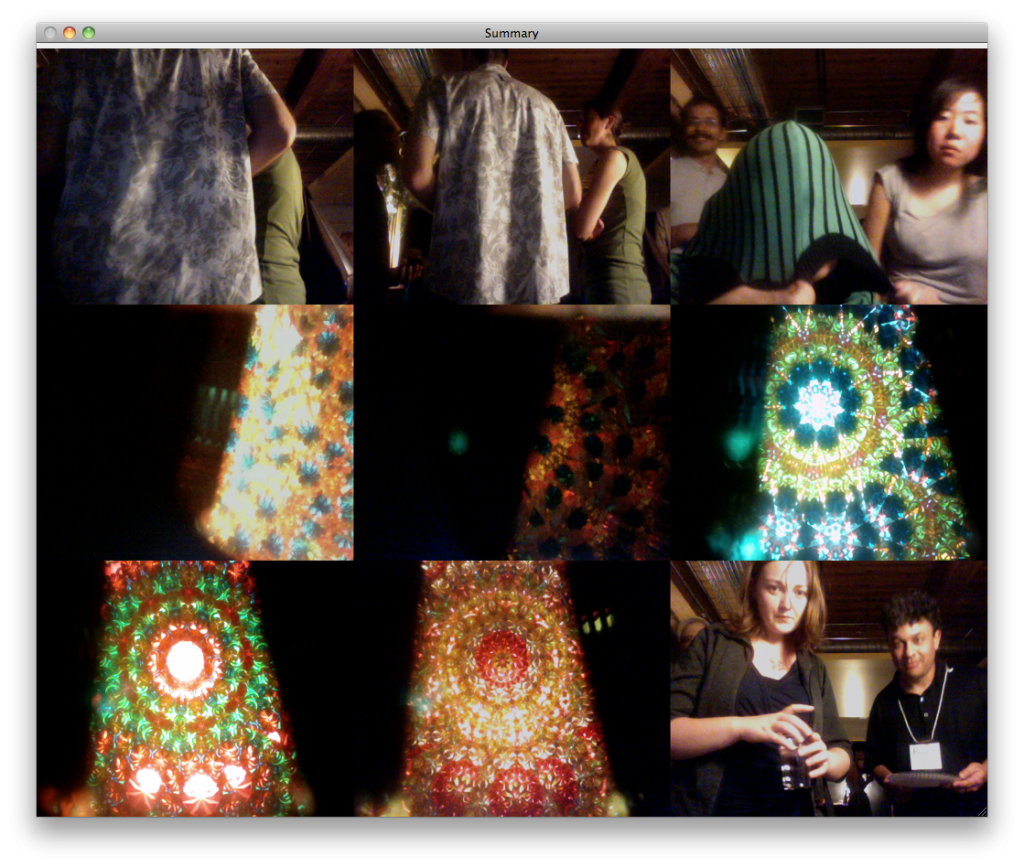SoYummy hits Subtle Technologies 2011
I just caught up on the sleep I missed during this year’s Subtle Technologies conference in Toronto where Yogesh Girdhar and I did a poster presentation on the SoYummy project. I wanted to do a post about the conference, who I met there, and thoughts on going forward.
The third annual Subtle Technologies festival/conference continued in the Art+Science vein of the previous years. There wasn’t a specific theme this year, but the talks and posters were well enough related to provide a consistent experience. Just because the conference was Art oriented doesn’t mean that all the talks were exciting though. Australian artist Mary Rosengren’s presentation about her collaboration with scientists was too general and at times aggravating while refusing to resolve into a coherent idea at the end. Robyn Moody—who creates fascinating kinetic sculptures related to relevant social topics—was unable to speak about the work in a cohesive way when he wasted 10 whole minutes on an unrelated introduction about the woes of vaccine paranoia.
I experienced several stellar presentations. I wasn’t able to catch all of them, but the scientists Ben Schumacher of Kenyon College and the zany Stephen Morris gave illuminating and engaging talks ranging from the consequences of Eistein’s relativity to patterns in nature. The vibrant Ben Schumacher explained how traveling faster than the speed of light would also mean traveling back in time. Stephen Morris showed how the fascinating formation called The Giant’s Causeway in Ireland was formed and how the same uniform cracking can be repeated at home.
Impassioned presentations by Italian curator Marco Mancuso illuminated larger connections between scientific and artistic research. Two dance related presentations by artists and choreographers Gail Lotenberg and Carl Flink showed innovative collaborations with scientists which resulted in beautiful dance performances captured on video. Jenny Leary’s nuanced advances in magnetic craft techniques traced the trajectory of an artist/inventor.
While some presenters strategically left out specifics, a few did so to their detriment. Riccardo Castagna and Valentina Margaria gave a concise and engaging presentation about their multi-modal Biomatics Virus. The idea itself seemed a bit of a rehash of the Neil Stephenson novel Snowcrash. The music that they generated from a 3D model of the H1N1 virus sounded great though. However, when asked by the audience about their process for converting virus structure data to make the music sound nice, they answered that they did nothing to smooth the raw data, further obscuring the connections between their science and art. Alan Majer’s (of Goodrobot.com) presentation on the other hand was strategically vague in order to open up room for the imagination: how would our society change if we could physically connect our brains together?
Yogesh Girdhar (aka Yogi) and I got a lot of attention with our poster, especially because we ran a demo of the latest software on a laptop. The software uses open source computer vision libraries to quantify the video coming in. It then uses Yogi’s unique qualification algorithm to decide how surprising an incoming video frame is (compared to what was already seen). If the input is surprising, the still is added into the summary of 9 images. We presented the demo as a contest to excite people to try to surprise the computer and make in into the summary. This was mega fun, and here is the resulting summary of the winners:
Socially I was lucky to meet and hang out with some amazing artists. Ted Hiebert, an artist and educator from University of Washington Bothell, blew our minds with his “plausible impossibilities” and descriptions of his telekinesis contests. Doug Jarvis, an artist-in-residence fellow at the Center for Studies in Religion and Society at University of Victoria BC, described the implications of brain cells in our gastrointestinal tract. I was psyched to meet a key member of the Yes Men: the artist and animator Patrick Lichty. Patrick is creative and generous artist and educator and is now working with Second Life and on cloning William S. Burroughs from a preserved turd. I also enjoyed conversations with Cara-Ann Simpson, Gail Kenning, Eva Kekou, Daryn Bond, Willie LeMaitre, and ginger coons (who gave me a copy of her amazing magazine produced using only free and open source software) among others. The social dynamics culminated with dancing at the party thrown by conference organizer and Director of Programs Jim Ruxton where we set up yet another Surprise Contest. Here is the summary images of the winners:
In conclusion I would like to thank Jennifer Dodd for helping with the logistics and poster curator Lorena Salome for the vital help with the poster. Thanks to Subtle Technologies for having us there. It seems that the talking presentation slots were reserved for those people who’ve taken their project into the world and have documentation of the interactions with other people. I would like to get our project to that level and do a presentation at Subtle Tech next year.



1 comment